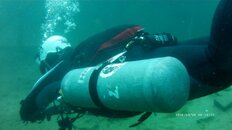@stuartv you're using the swivel on the left side to get the hoses to come up at the optimal angle. It's not a huge deal, and while it is a passive use of it since it shouldn't move under normal diving circumstances. It becomes a bit more active during double bottle off restrictions.
@Schwob unfortunately not for a book. The best place for sidemount is still to find someone that actually dives sidemount and start asking questions. Thankfully there are a bunch of those around.
Fiddling is inevitable if you want your gear to look perfect. Sidemount is a variable system because the tanks are rigidly fixed to your body like in backmount. Pros and cons. For open water, getting "good enough" is real easy, heck for cave diving is pretty easy. Getting it perfectly ironed out is something that every real active sidemount diver is constantly chasing. Sidemount being a dynamic system is going to be very gear and individually dependent. Where is the specific CoB on the diver, what kind of tanks, what kind of exposure protection, etc etc. and that is different from diver to diver. There are certain guidelines as mentioned above that will get you "close enough" but not perfect.
5th port is a personal preference thing. Biggest advantage on the right side is that your long hose can swivel forward during single file air shares independently of a drysuit inflator. If you only dive wet, you won't have that inflator, and if you dive recreationally with a 7' hose, you probably won't be fully deploying that hose so it doesn't really matter. On the left, i think it's just a nitpicky thing but I actually find it really annoying to have those short inflators where I go for a bottle off restriction as it puts rotational torque on my inflator which I find uncomfortable. It is also not really compatible with my bottle position and I haven't messed with it in probably 3 years since I didn't have a 5 port first stage. I have some MK25's now and will be messing with some bottom port configurations on my next dive trip in 2 weeks, so I may change my mind.
Fiddling can pose somewhat problematic in a dive team if you have different philosophies on sidemount. I.e. a Toddy diver with a Florida diver would be problematic. Toddy is AL only, and bottle donation. Florida is long hose with steels. Toddy can take a long hose from Florida, but can't give up that bottle if Florida needed to share air.
UTD poses no real issues in compatibility with Florida because long hose sharing is still feasible in an OOA situation.
@victorzamora have similar but different philosophies with our gear configuration, but have no issues diving together or understanding our gear. Our tanks believe it or not are actually interchangeable if we wanted to and while trim may be a bit weird, it would still be diveable. Deco/stage bottles are somewhat different with him using turrets and shorter hoses vs. my using fixed first stages and longer hoses, but they're still compatible. The key is to go through pre-dive checks and understand any strange nuances to gear configurations that are going to be really different I.e. if someone is using a butt pouch vs. hip pockets for storage of stuff, or line cutter placement. Everything else isn't going to be passed from one diver to the other, so it shouldn't really matter.
A sidemount class is great if you want to skip the gear tinkering process, don't have access to a mirror/camera to self-evaluate, or want to rapidly expedite that process provided that the instructor knows what they're doing. I saw some sidemount divers this weekend in a gear config class that was positively terrifying and it seems that that is what most of the sidemount instruction looks like especially if the instructors aren't active cave or wreck penetration divers. Again, it may work fine for open water and be "good enough", but there is a massive difference between what will get you by in that environment and what will get you through a true sidemount restriction safely. Remember that those of us that have been diving sidemount before the agencies really got into making money on it had to figure it all out on our own.
We all went through evolution and many of us without training because it wasn't available at the time
Early sidemount before I had seen any pix or reflections of myself. Set up out of the box with the bungees similar to the Razor, etc. No loop bungee kits out yet from Edd, no ring bungees yet from Dive Rite, etc etc. Working with what we had.
Slightly later in 2010. This is with ring bungees and pulled up a bit tighter
skip a few to 2016 and the tanks are nice and flat, pulled back behind my arm pits, etc. with loop bungees and slow but sure evolution.
no certifications required to dive locations unless Europe has some training requirements for privately owned sites. May be a few in the US, but none that I'm aware of. There are some caves that are restricted to sidemount only, but if there was a cert requirement there would be a bunch of us certifying each other over the phone to get the card because we needed it.




